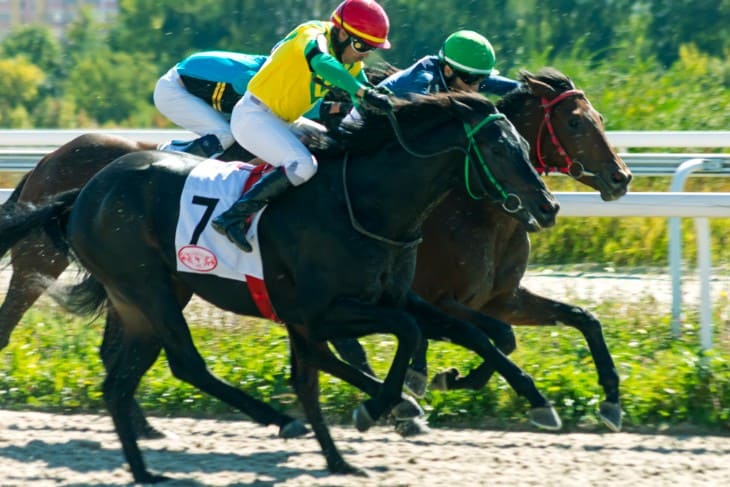- Understanding Leader Chasing Tactic
- The Logic Behind Leader Chasing
- When To Apply For Leader Chasing In Horse Racing
- Risking and Warning along with Chief Pursuit
- The Role of Track Conditions in Leader-Chasing
- Analysing Jockey-Horse Chemistry for Successful Leader Chasing
- Case Studies: Memorable Leader Chasing Wins in Horse Racing
- Strategies for Mitigating Risks in Leader Chasing
- Takeaway
In horse racing, where fortunes can change in a second, it's important to have a winning betting strategy. One such is "Chasing the Leader" which has gained popularity amongst experienced punters. In this article, we will look at this tactic in detail and see how it can be applied well within the framework of a horse race.
Understanding Leader Chasing Tactic
In horse racing, leader chasing means you are putting down your stake in the current leader. Sounds simple right? But there is an intelligent way behind it.
When you are backing the leader, you rely on that horse maintaining its place in the race and continuing with the same impressive performance that it has shown so far. Essentially, you are wagering on its momentum and skill.
Why bet on the leader when the odds are typically lower? These horses get to lead for a reason. They have displayed exceptional speed, form, and tactics to be in that position.
By placing your bet on the leader horse, you believe that they can carry through their current strength until the finish line. It's like having faith in maintaining an impressive run by a particular home.
This gaming is particularly very effective when done during in-play betting because you can evaluate how the game is changing as time goes by. This happens when one sees a horse taking commanding strides or showing consistent traits of front running among others.
Leader Chasing – A Winning Methodology
So what does Leader Chasing mean? Well here we go; It means that if only I could let you know how amazing this strategy is… Leader chasing combines astute observation with in-play betting making it an enticing option for those who wish to excel in thrills of horseracing.
The Logic Behind Leader Chasing
You may ask why someone should put their money on a horse that's already leading other runners in terms of pace/velocity or even agility/dexterity etcetera yet it's true? It's not rocket science and the odds will always be against you no matter how much effort you put in. But still, there is a solid logic behind this approach.
By backing the leader, you are essentially putting your faith in its current form. This horse is leading because it has great speed, shape and tactics to outsmart others. It has beaten some of its competitors and established itself as the one to beat.
In essence, when betting on the leader you are capitalising on its momentum and chances that it would continue performing well. It’s like betting that the winning streak will not stop.
While odds may not be that attractive for a favourite compared to an underdog, they do often indicate a higher probability of success. The reason is that this pony has already shown its ability to stay ahead making it somehow less risky a bet.
It must be remembered that in horse racing there are no absolutes; circumstances change rapidly. Even the front runner can lose control because of things such as fatigue competition or race field conditions
Therefore Leader Chasing is indeed a promising strategy but even so it doesn’t come without risks, these two need balancing.

When To Apply For Leader Chasing In Horse Racing
Knowing when to use leader-chasing tactics while participating in horse racing is crucial for success. Below are moments where this strategy should be considered:
- An Overwhelming Start: It is important to note races where a horse carries on to dominate from the start. Any horse that starts well and stays at an appreciable advantage is a big influence for Leader Chasing. This motion, which sees the horse take control of the race from its onset, may give it an edge.
- Consistency Tested: Look out for horses that have displayed their ability to hang around near or at the front of the pack in previous events. Such horses are good bets for Leader Chasing since they consistently lead in other previous races. Their ability to stay ahead is indicative of great skills and efficiency.
- Track Favourability: Assess the race conditions, especially track type. In cases where some horses are better suited for particular tracks if a leader is performing so well in present conditions, hope burns bright. For example, if a turf specialist has returned to run on turf again, then it's time you started thinking about Leader Chasing.
- Rider Experience: Consider both; the jockey's expertise and experience alongside what the animal is capable of doing on track. If in past races there was a certain jockey who succeeded in getting this horse out in front first then this can increase chances of hanging onto such a position. This could make all the difference as far as knowledge about pacing and strategy is concerned when we talk about jockeys' history.
Risking and Warning along with Chief Pursuit
The risks involved with Leader Chasing should be considered cautiously when entering into Horse Racing games. The following are some important things to consider:
- No Certainties in Racing: Racing horses is inherently uncertain. Even if a particular horse happens to be leading there is never any guarantee that it will still be where it should be come finish line time; An assortment of factors like tiredness or the presence of other racers might abruptly change results here thus one should always bear in mind that gambling on horses implies risk.
- Lower odds: Betting on the leader tends to give a lower return than betting on other runners. This may reduce your potential winnings but it also indicates increased chances of winning. Therefore, you have to assess the risk-reward ratio first and determine if these lower odds are in line with your betting strategy.
- In-Play Betting Awareness: Leader Chasing is tailored for In-play betting where one can monitor how the race unfolds. However, this will necessitate a good knowledge of rules governing In-play betting so that timely decisions can be made. Expecting your plan to change as events occur during an ongoing race.
- Research Matters: When chasing leaders, extensive research helps mitigate risks. Know the strengths and weaknesses of the leading horse as well as its competitors and any recent changes in race dynamics. By looking at previous performances, track records and jockey-horse partnerships, you can learn more about which bets would be most profitable.
- Maintain Discipline: Your attitude towards gambling is very important; set limits for yourself and stick to them while placing bets. Avoid chasing losses or raising stakes without gut feeling reckless since this becomes risky business in the case of Leader Chasing unless you want big profits at stake due to such discipline that will enable thorough observance of a well-laid-out plan when it comes to gambling.
The Role of Track Conditions in Leader-Chasing
Track conditions play a major role in determining whether a horse performs well or not thus ultimately affecting Leader-Chasing Strategy in horse racing games. Understanding track conditions is very important when making conscious gambling choices.
Different horses prefer different track conditions. Some run better on hard, dry tracks while others are more comfortable running on softer wet ones. The type of a track can influence a horse's speed, and endurance and make it feel at ease during the race.
When considering Leader-Chasing, one needs to establish if current track conditions suit the leader’s preference. It is a good sign if the leading horse has previously performed well on this particular type of track. Horses that like the track they are running on have high chances of maintaining their lead and performing consistently.
However, if the leader does not favour such track conditions then he or she may lose leadership here easily. For instance, excellent performance by a horse on dry tracks is not guaranteed when it comes to wet or muddy courses.
To make the most of the Leader-Chasing strategy, bettors should pay close attention to weather forecasts and track condition updates. This information can help you assess whether the leader is likely to maintain its position based on the current track conditions.
Track conditions play a vital role in Leader-Chasing in horse racing. Understanding the leader's compatibility with the current track type can provide valuable insights into the horse's ability to maintain its lead. By considering these factors alongside other research, you can make more informed and calculated betting decisions when applying the Leader-Chasing strategy.
Analysing Jockey-Horse Chemistry for Successful Leader Chasing
In the world of horse racing, the synergy between the jockey and the horse can make all the difference, especially when employing the leader-chasing strategy. Let's delve into how analysing this unique chemistry can lead to successful Leader-chasing outcomes.
First and foremost, it's essential to understand that jockeys are more than just riders; they are skilled athletes who play a pivotal role in a horse's performance. When a jockey and a horse work together seamlessly, it can lead to impressive results.
To assess the jockey-horse chemistry, one must consider past races where the same jockey rode the horse to a lead. If there's a history of successful collaborations, it's a promising sign. It indicates that the jockey understands the horse's preferences, pace, and temperament, all of which are critical factors in maintaining a lead.
Consistency is another key aspect to evaluate. Check how often the jockey-horse combination has achieved front-running positions in previous races. A track record of maintaining the lead suggests a strong partnership, where both the jockey and the horse understand each other's strengths and strategies.
Moreover, track familiarity can significantly influence the leader's chances of maintaining their position. Some horses perform better on specific track types or under particular race conditions. If the jockey and horse have shown success on the current track or under similar circumstances, it boosts confidence in their ability to sustain the lead.
Effective communication between the jockey and the horse is crucial. A jockey who can convey race strategy to the horse and adapt to changing situations enhances the chances of maintaining the lead. Look for instances where the jockey demonstrated strategic awareness in previous races.

Case Studies: Memorable Leader Chasing Wins in Horse Racing
Examining real-life case studies of memorable Leader Chasing victories in horse racing can provide valuable insights into the effectiveness of this strategy:
- Secretariat's Triple Crown: Perhaps one of the most iconic Leader Chasing moments in horse racing history was Secretariat's remarkable Triple Crown victory in 1973. Known for his incredible speed, Secretariat consistently led races from start to finish. His breathtaking performance in the Belmont Stakes, where he won by an astonishing 31 lengths, showcased the power of maintaining a dominant lead.
- Red Rum's Grand National Dominance: Red Rum, a legendary steeplechaser, secured his place in horse racing history with three Grand National wins in the 1970s. Red Rum's ability to maintain his position at the front of the field, even over challenging jumps, demonstrated the effectiveness of Leader Chasing in demanding races.
- American Pharoah's Grand Slam: American Pharoah's 2015 season will be remembered for his Grand Slam victories, including the Triple Crown and the Breeders' Cup Classic. His jockey, Victor Espinoza, expertly guided him to maintain the lead in each race, showcasing the synergy between jockey and horse in successful Leader Chasing.
- Frankel's Undefeated Streak: Frankel, the undefeated British thoroughbred, was known for his exceptional front-running abilities. His jockey, Tom Queally, consistently positioned him at the front of the field, allowing Frankel to secure 14 consecutive victories and establish himself as one of the greatest racehorses in history.
Strategies for Mitigating Risks in Leader Chasing
When it comes to Leader Chasing in horse racing, managing risks is essential. Here are some practical strategies to help you mitigate risks and make more informed betting decisions:
- Thorough Research: Before placing your bet on the leader, invest time in thorough research. Study the horse's past performances, including recent races, track records, and running styles. Understanding the horse's strengths and weaknesses is key to making an informed decision.
- Evaluate Track Conditions: Track conditions can significantly impact a horse's performance. Some horses excel on firm tracks, while others thrive on softer ground. Check the current track conditions and whether they align with the leader's preferences. A horse comfortable with the prevailing conditions is more likely to maintain its lead.
- Monitor In-Play Betting: Leader Chasing is well-suited for in-play betting, where you can assess the race as it unfolds. Keep a close eye on the race dynamics, the leader's stamina, and how other horses are closing the gap. Be prepared to adapt your strategy based on real-time developments.
- Set a Betting Budget: Betting discipline is crucial in mitigating risks. Set a budget for your bets and stick to it. Avoid chasing losses or increasing your stakes impulsively. A well-defined betting plan helps you manage your bankroll effectively.
- Consider Hedging Bets: Hedging involves placing additional bets to reduce potential losses or secure a profit. In the context of Leader Chasing, you might consider placing a hedge bet on a strong competitor if you notice signs of the leader faltering. This way, you can mitigate losses or secure a profit, even if the leader doesn't maintain its position.
Takeaway
Chasing the leader in horse racing can be a rewarding strategy when executed thoughtfully. It leverages the current performance and momentum of a front-running horse. However, it's vital to exercise caution, as no strategy in horse racing comes with guarantees.
Effective Leader Chasing requires a blend of astute observation, research, and timely decision-making, particularly in the context of in-play betting. By assessing the situation, evaluating the leader's capabilities, and weighing the risks, you can enhance your chances of success in the dynamic and thrilling world of horse racing betting.








